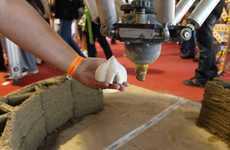
The 'ArboSkin' is Has CNC-milled Parts Made of Bioplastic
Laura McQuarrie — November 27, 2013 — Eco
References: itke.uni-stuttgart.de & dezeen
This sustainable pavilion in Stuttgart, Germany is made up of a bioplastic that contains of materials that are over 90% renewable. This includes materials like starches, cellulose, lignin, biopolymers and other alternatives to plastic. The materials of the ‘ArboSkin’ were produced by Tecnaro and the sculpture was put together by students and professors from Stuttgart University ITKE.
Although its form is unconventional, ArboSkin demonstrates the possibilities of bioplastic materials could have on the construction industry, as well as the implications it could have as a sustainable material.
To form the incredible structure, the triangular cells that make up ArboSkin were liked together with bracing rings and joists. In certain spots, CNC machines were used to make cutouts to demonstrate the versatility of the material.
Although its form is unconventional, ArboSkin demonstrates the possibilities of bioplastic materials could have on the construction industry, as well as the implications it could have as a sustainable material.
To form the incredible structure, the triangular cells that make up ArboSkin were liked together with bracing rings and joists. In certain spots, CNC machines were used to make cutouts to demonstrate the versatility of the material.
Trend Themes
1. Bioplastic Construction - Construction companies could explore the use of bioplastics as a sustainable alternative to traditional plastic materials in building design.
2. Renewable Materials - Industries that rely on materials could explore the use of renewable materials such as starches, cellulose, and lignin to create more eco-friendly products.
3. CNC Machining for Bioplastics - CNC machine manufacturers could explore the use of bioplastics as a new material for machining, creating a new market opportunity.
Industry Implications
1. Construction - The construction industry could explore the use of bioplastics to create eco-friendly buildings and structures.
2. Manufacturing - Manufacturing industries could use renewable materials to create more sustainable products.
3. Machinery - Machinery industries could explore the use of bioplastics as a new material for machining, creating a new market opportunity.
5.4
Score
Popularity
Activity
Freshness























